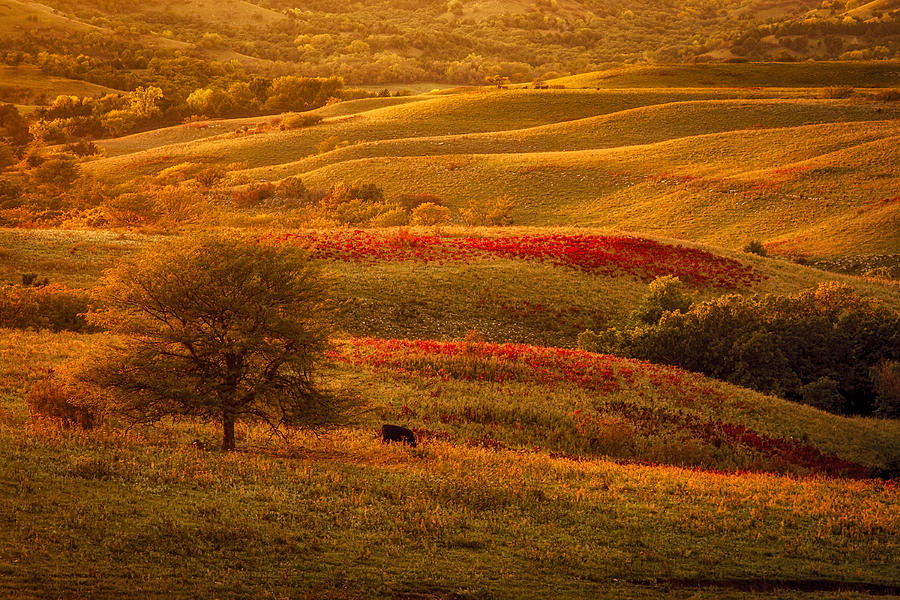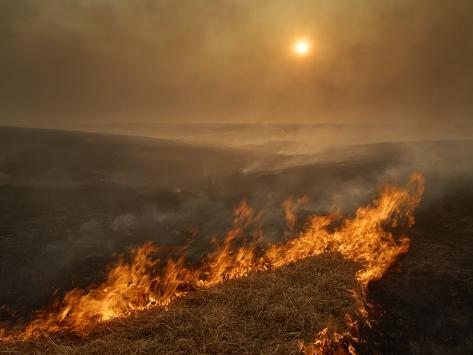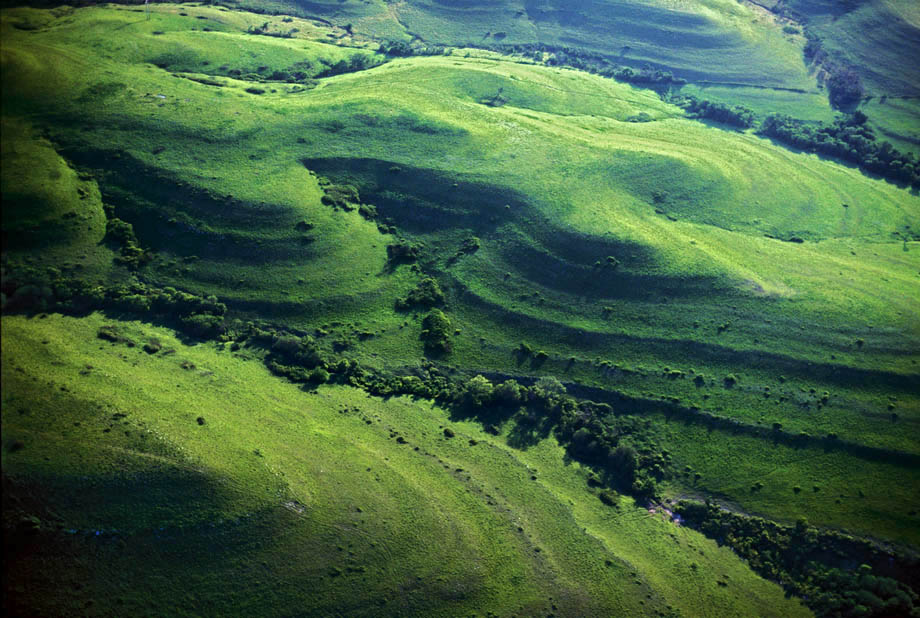The Annual Burning of the Tall Blue Stem Grasses of KS
Page 1 of 1
 The Annual Burning of the Tall Blue Stem Grasses of KS
The Annual Burning of the Tall Blue Stem Grasses of KS
Jim Hoy at Flying W Ranch. Clements, KS, United States ·
"Fire Season” by Jim Hoy
Spring is almost here, and soon I’ll be smelling the sweet odor of burning grass wafting in on the southern breeze. Anyo...ne who has lived in the Flint Hills knows that pasture burning is an annual rite of spring here in the tallgrass prairie.
There are those who start burning in March, but I like to wait until mid-April after the weeds have begun to green up so that they will get killed back and leave a clear field for the grass. Range management authorities suggest that late April and early May is even better because not only will get a better kill on weeds and brush, but the ground will also be warmer and the grass will come on faster.
The range management authorities may well be right about that, but they have not always been right. Up until after mid-twentieth century agricultural scientists advocated strongly against burning, but they were fighting a losing battle. Farmers and ranchers in the Flint Hills had been burning since pioneer times, in opposition to both popular and scientific opinion. And before that, the Indians native to this area had burned off the old grass each spring.
Oral tradition from the Council Grove area, site of the last Kaw Indian reservation in Kansas, records just how the Indians burned in the spring. After gathering a large amount of dead grass and wrapping it into a big ball with rawhide thongs, a young man would mount his horse, tie a rawhide lariat onto the ball, have it set on fire, then drag the burning ball as fast and as far as he could, setting huge amounts of prairie ablaze.
By at least 1863 white settlers had adopted the Indian practice, but not the method, of burning. That was the year in which Elisha Mardin, who lived near Bloody Creek in Chase County, recorded in his diary an accidental fire in March, then several intentional ones in April. By the end of the nineteenth century most ranchers were burning in March, some even as early as February, in preparation for the arrival of Texas cattle. Such early burning might have meant fresh grass for the steers in mid-April, but it also meant more erosion from spring rains and a less efficacious weed kill.
Ag scientists at K-State, who knew (with certainty, they wrongly thought) burning was bad, began experimenting with intentional burning in the teens and continued into the 1950s, but somehow the results weren’t as dire as they had expected. They still opposed burning but were forced to temper their findings with the recommendation that if you insisted on burning, you should do it later rather than earlier.
About this time Clenton Owensby, who had a different view of fire, joined the faculty. From New Mexico, Owensby thought of fire as a part of nature, but conducting experiments with intentional fire in New Mexico presented problems. After all, New Mexico is the home of Smokey the Bear, whose anti-forest-fire effort is perhaps the most successful government program ever devised. But Owensby’s experiments in the Flint Hills proved that the folk practice of ranchers and farmers had been sound all along. A pasture, burned at the proper time, would produce just as much forage as an unburned one. More important, cattle would gain significantly more on burned grass than on unburned.
Some people are concerned that the smoke from intentional pasture burning contributes to the proliferation of carbon in the atmosphere, but in reality that carbon (and more) is put right back into the soil by the growing grass. It’s a natural process, unlike the pollution from automobile exhaust, which goes right into the atmosphere.
Last summer was one of the best for grass we’ve had in a long time. Rains came along as needed, without a prolonged dry spell. There is lots of tall dead grass in the tallgrass prairie this spring.
The fires will be spectacular.
Images of the FLINT HILLS OF KANSAS
Fall - Early March


The tall Blue Stem morphs into such brilliant color shades from spring greens to
the dusty beige colors and into the blazing deep rusts shades by winter time.


Depending on wind conditions the Annual Pasture Burning begins in March > > >




The smoky haze will settle over many acres of other communities and breathing issues
have caused some to just relocate during this burning season --- it is a serious lung issue for many.



And then the grasses start their rebirth process into that brilliant shades of greens
and the wild flowers have reseeded and the colors are intense and wide spread

Not as flat as some people believe...we have many areas that the elevations drops
off drastically and loads of inland sea type fossils are found.

*********************
Please forgive me my bragging...but this is such a wonderful place to 'breathe deeply'
and allow mother nature to fortify your soul~~~
"Fire Season” by Jim Hoy
Spring is almost here, and soon I’ll be smelling the sweet odor of burning grass wafting in on the southern breeze. Anyo...ne who has lived in the Flint Hills knows that pasture burning is an annual rite of spring here in the tallgrass prairie.
There are those who start burning in March, but I like to wait until mid-April after the weeds have begun to green up so that they will get killed back and leave a clear field for the grass. Range management authorities suggest that late April and early May is even better because not only will get a better kill on weeds and brush, but the ground will also be warmer and the grass will come on faster.
The range management authorities may well be right about that, but they have not always been right. Up until after mid-twentieth century agricultural scientists advocated strongly against burning, but they were fighting a losing battle. Farmers and ranchers in the Flint Hills had been burning since pioneer times, in opposition to both popular and scientific opinion. And before that, the Indians native to this area had burned off the old grass each spring.
Oral tradition from the Council Grove area, site of the last Kaw Indian reservation in Kansas, records just how the Indians burned in the spring. After gathering a large amount of dead grass and wrapping it into a big ball with rawhide thongs, a young man would mount his horse, tie a rawhide lariat onto the ball, have it set on fire, then drag the burning ball as fast and as far as he could, setting huge amounts of prairie ablaze.
By at least 1863 white settlers had adopted the Indian practice, but not the method, of burning. That was the year in which Elisha Mardin, who lived near Bloody Creek in Chase County, recorded in his diary an accidental fire in March, then several intentional ones in April. By the end of the nineteenth century most ranchers were burning in March, some even as early as February, in preparation for the arrival of Texas cattle. Such early burning might have meant fresh grass for the steers in mid-April, but it also meant more erosion from spring rains and a less efficacious weed kill.
Ag scientists at K-State, who knew (with certainty, they wrongly thought) burning was bad, began experimenting with intentional burning in the teens and continued into the 1950s, but somehow the results weren’t as dire as they had expected. They still opposed burning but were forced to temper their findings with the recommendation that if you insisted on burning, you should do it later rather than earlier.
About this time Clenton Owensby, who had a different view of fire, joined the faculty. From New Mexico, Owensby thought of fire as a part of nature, but conducting experiments with intentional fire in New Mexico presented problems. After all, New Mexico is the home of Smokey the Bear, whose anti-forest-fire effort is perhaps the most successful government program ever devised. But Owensby’s experiments in the Flint Hills proved that the folk practice of ranchers and farmers had been sound all along. A pasture, burned at the proper time, would produce just as much forage as an unburned one. More important, cattle would gain significantly more on burned grass than on unburned.
Some people are concerned that the smoke from intentional pasture burning contributes to the proliferation of carbon in the atmosphere, but in reality that carbon (and more) is put right back into the soil by the growing grass. It’s a natural process, unlike the pollution from automobile exhaust, which goes right into the atmosphere.
Last summer was one of the best for grass we’ve had in a long time. Rains came along as needed, without a prolonged dry spell. There is lots of tall dead grass in the tallgrass prairie this spring.
The fires will be spectacular.
Images of the FLINT HILLS OF KANSAS
Fall - Early March


The tall Blue Stem morphs into such brilliant color shades from spring greens to
the dusty beige colors and into the blazing deep rusts shades by winter time.


Depending on wind conditions the Annual Pasture Burning begins in March > > >




The smoky haze will settle over many acres of other communities and breathing issues
have caused some to just relocate during this burning season --- it is a serious lung issue for many.



And then the grasses start their rebirth process into that brilliant shades of greens
and the wild flowers have reseeded and the colors are intense and wide spread

Not as flat as some people believe...we have many areas that the elevations drops
off drastically and loads of inland sea type fossils are found.

*********************
Please forgive me my bragging...but this is such a wonderful place to 'breathe deeply'
and allow mother nature to fortify your soul~~~
Guest- Guest
 Re: The Annual Burning of the Tall Blue Stem Grasses of KS
Re: The Annual Burning of the Tall Blue Stem Grasses of KS
It's amazing how nature replenishes after fire, so many areas of the world where fire is essential to the ecology.
Guest- Guest
 Re: The Annual Burning of the Tall Blue Stem Grasses of KS
Re: The Annual Burning of the Tall Blue Stem Grasses of KS
quote
"Please forgive me my bragging...but this is such a wonderful place to 'breathe deeply'
and allow mother nature to fortify your soul~~~"
untill you get a lung ful of that smoke it seems
"Please forgive me my bragging...but this is such a wonderful place to 'breathe deeply'
and allow mother nature to fortify your soul~~~"
untill you get a lung ful of that smoke it seems

Victorismyhero- INTERNAL SECURITY DIRECTOR

- Posts : 11441
Join date : 2015-11-06
 Re: The Annual Burning of the Tall Blue Stem Grasses of KS
Re: The Annual Burning of the Tall Blue Stem Grasses of KS
Lord Foul wrote:quote
"Please forgive me my bragging...but this is such a wonderful place to 'breathe deeply'
and allow mother nature to fortify your soul~~~"
untill you get a lung ful of that smoke it seems
LMAO...that was rather 'IRONIC', wasn't it

Guest- Guest
 Re: The Annual Burning of the Tall Blue Stem Grasses of KS
Re: The Annual Burning of the Tall Blue Stem Grasses of KS
I spent 24 hrs driving from the Blue Ridge area of Texas to Houston once, you could sure breathe easy on that stretch, but I have never felt so small and insignificant in the universe ever.
Guest- Guest
 Re: The Annual Burning of the Tall Blue Stem Grasses of KS
Re: The Annual Burning of the Tall Blue Stem Grasses of KS
sassy wrote:It's amazing how nature replenishes after fire, so many areas of the world where fire is essential to the ecology.
And for everyone that settles here to live and they just can't fathom the way mother nature's used this annual burning: lightening strikes and the natives starting the fires --- well the number of pasture acreage for grazing would slowly and surely become covered with the evasive cedar trees that birds eat the seeds and then they get spread - or the Russian Thistles - mustard grasses and other aggressive weeds that will choke out the tall Blue Stem if it's not burnt off yearly.
Guest- Guest
 Re: The Annual Burning of the Tall Blue Stem Grasses of KS
Re: The Annual Burning of the Tall Blue Stem Grasses of KS
sassy wrote:I spent 24 hrs driving from the Blue Ridge area of Texas to Houston once, you could sure breathe easy on that stretch, but I have never felt so small and insignificant in the universe ever.
Up on I-70 there are 'high wind' advisories signs {lit up kind} warning high profile type of vehicles/motorcycles/semi-truckers about the wind currents, because that wind will blow you right off the highway.
Getting up pre-dawn and loading up the horse trailer to start moving cattle out to the range to graze is just one of the best of the things that I've ever done; everything is still so still and hazy from the morning fog/dew and even the cattle or subdued and easy to move from place to place --- just such a hush and a wonderful harmony about these hills.
Guest- Guest
 Re: The Annual Burning of the Tall Blue Stem Grasses of KS
Re: The Annual Burning of the Tall Blue Stem Grasses of KS
Sounds lovely. Stayed on a ranch in the Blue Ridge area, had a wonderful time.
Guest- Guest
 Similar topics
Similar topics» I'm a 6foot 5inch tall chinese woman
» Get ready for Robohunk: Sex doll makers set to launch 6ft tall model made for women with rippling muscles and brooding looks
» Did You Get An Annual Bonus - What Will You Spend It On?
» Say What Annoyed You Today
» CST Annual Antisemitism Stats – It’s a Bit Worse
» Get ready for Robohunk: Sex doll makers set to launch 6ft tall model made for women with rippling muscles and brooding looks
» Did You Get An Annual Bonus - What Will You Spend It On?
» Say What Annoyed You Today
» CST Annual Antisemitism Stats – It’s a Bit Worse
Page 1 of 1
Permissions in this forum:
You cannot reply to topics in this forum
» TOTAL MADNESS Great British Railway Journeys among shows flagged by counter terror scheme ‘for encouraging far-right sympathies
» Interesting COVID figures
» HAPPY CHRISTMAS.
» The Fight Over Climate Change is Over (The Greenies Won!)
» Trump supporter murders wife, kills family dog, shoots daughter
» Quill
» Algerian Woman under investigation for torture and murder of French girl, 12, whose body was found in plastic case in Paris
» Wind turbines cool down the Earth (edited with better video link)
» Saying goodbye to our Queen.
» PHEW.
» And here's some more enrichment...
» John F Kennedy Assassination
» Where is everyone lately...?
» London violence over the weekend...
» Why should anyone believe anything that Mo Farah says...!?
» Liverpool Labour defends mayor role poll after turnout was only 3% and they say they will push ahead with the option that was least preferred!!!
» Labour leader Keir Stammer can't answer the simple question of whether a woman has a penis or not...
» More evidence of remoaners still trying to overturn Brexit... and this is a conservative MP who should be drummed out of the party and out of parliament!
» R Kelly 30 years, Ghislaine Maxwell 20 years... but here in UK...